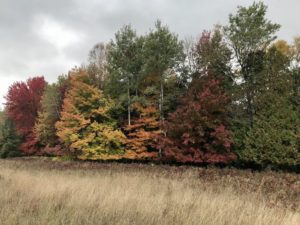 We’ve had it good so far this autumn. Bird migration and the seasonal die-back of plants are still the most notable aspects of the season, and both are advancing at a swift pace now. Bird migration began in July, and increased in August. Many birds which travel the farthest south- some of the warblers, swallows, sandpipers- start their travels early, and are difficult to see when all the leaves are still on the trees. Birdwatching this time of year takes extra patience because many birds are not as colorful now as they were earlier, they don’t sing like they do during nesting season, and the creep through the foliage which hides them well. We hardly notice the first migrants’ movements, and many of the birds are found here during the summer so it’s hard to tell the difference.
We’ve had it good so far this autumn. Bird migration and the seasonal die-back of plants are still the most notable aspects of the season, and both are advancing at a swift pace now. Bird migration began in July, and increased in August. Many birds which travel the farthest south- some of the warblers, swallows, sandpipers- start their travels early, and are difficult to see when all the leaves are still on the trees. Birdwatching this time of year takes extra patience because many birds are not as colorful now as they were earlier, they don’t sing like they do during nesting season, and the creep through the foliage which hides them well. We hardly notice the first migrants’ movements, and many of the birds are found here during the summer so it’s hard to tell the difference.By late August, though, birds not found here earlier start showing up. Swainson’s thrushes can be abundant, having come all the way from British Columbia. Gray-checked thrushes often show up at the same time. There are many warblers about, species that nest here and those from farther north. During bird banding this fall, we caught Nashville, magnolia, and other warblers from the north, along with Philadelphia vireos, catbirds, and others. At times in September the catbirds seemed to be mewing from every shrub.
In mid-late September hawks were migrating high overhead, while robins invaded in huge numbers. Flickers, sapsuckers, brown creepers, and ruby and golden-crowned kinglets were numerous. Each night, millions of songbirds flew overhead in the dark, only their peeping gives them away. Then, white crowned and white-throated sparrows came, as more summer birds like hummingbirds departed. At the end of the month, juncos started to arrive, signaling that colder weather is not far off.
Now, the white-crowned and white-throats are thinking about moving on. There are still lots of robins, catbirds, wrens, and other hardier summer birds, but more juncos are arriving, and soon we will start to see the winter ducks out on Lake Michigan. Any day now, saw-whet owls will show up, and we are just barely ready to catch and band some as they move through.
All of these changes flow like a great current of living things. Even if one isn’t outdoors for long periods, if you pay attention you can catch glimpses of the changes every day. While Florida has had hurricanes, we have golden warm afternoons, with beautiful leaves and trees loaded with birds. The older you get, the more you appreciate Wisconsin, Manitowoc County, and our lakeshore. Appreciate and enjoy what we have, and protect it. And enjoy the change of season.
Photo- fall colors at Dunes, by our staff.
